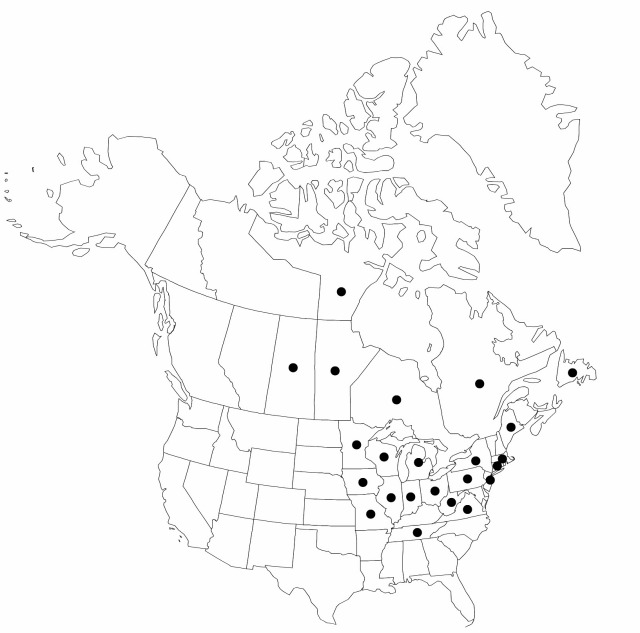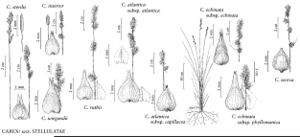Difference between revisions of "Carex sterilis"
Sp. Pl. 4(1): 208. 1805.
FNA>Volume Importer |
imported>Volume Importer |
||
| (6 intermediate revisions by 2 users not shown) | |||
| Line 8: | Line 8: | ||
}} | }} | ||
|common_names=Carex stérile | |common_names=Carex stérile | ||
| + | |special_status={{Treatment/ID/Special_status | ||
| + | |code=F | ||
| + | |label=Illustrated | ||
| + | }}{{Treatment/ID/Special_status | ||
| + | |code=E | ||
| + | |label=Endemic | ||
| + | }} | ||
|basionyms= | |basionyms= | ||
|synonyms={{Treatment/ID/Synonym | |synonyms={{Treatment/ID/Synonym | ||
|name=Carex elachycarpa | |name=Carex elachycarpa | ||
|authority=Fernald | |authority=Fernald | ||
| − | }}{{Treatment/ID/Synonym | + | |rank=species |
| + | }} {{Treatment/ID/Synonym | ||
|name=Kobresia elachycarpa | |name=Kobresia elachycarpa | ||
|authority=(Fernald) Fernald | |authority=(Fernald) Fernald | ||
| + | |rank=species | ||
}} | }} | ||
|hierarchy=Cyperaceae;Carex;Carex sect. Stellulatae;Carex sterilis | |hierarchy=Cyperaceae;Carex;Carex sect. Stellulatae;Carex sterilis | ||
| Line 38: | Line 47: | ||
-->{{#Taxon: | -->{{#Taxon: | ||
name=Carex sterilis | name=Carex sterilis | ||
| − | |||
|authority=Willdenow | |authority=Willdenow | ||
|rank=species | |rank=species | ||
| Line 52: | Line 60: | ||
|publication title=Sp. Pl. | |publication title=Sp. Pl. | ||
|publication year=1805 | |publication year=1805 | ||
| − | |special status= | + | |special status=Illustrated;Endemic |
| − | |source xml=https:// | + | |source xml=https://bitbucket.org/aafc-mbb/fna-data-curation/src/2e0870ddd59836b60bcf96646a41e87ea5a5943a/coarse_grained_fna_xml/V23/V23_581.xml |
|genus=Carex | |genus=Carex | ||
|section=Carex sect. Stellulatae | |section=Carex sect. Stellulatae | ||
Latest revision as of 20:41, 5 November 2020
Culms 10–75 cm. Leaves 3–5 per culm; sheaths tight, inner band hyaline, 4–13 cm, apex concave, glabrous; ligules 0.3–1.7 mm, rounded to obtuse; blades plicate, 7.5–25 cm × 1.2–2.6 mm, widest leaf 1.6–2.6 mm wide. Inflorescences densely crowded distally, often with basal spikes ± separate, 0.9–4 cm; spikes 3–8; unisexual with pistillate and staminate spikes on different plants; pistillate plants rarely with few staminate flowers; staminate plants sometimes with few pistillate flowers scattered on spikes or, occasionally, entirely pistillate spikes mixed with entirely staminate ones in same inflorescence; proximal 2 spikes 3.8–15.5 mm apart, lateral spikes 3–13.5 mm, similar to terminal spikes; terminal spikes 3.5–13.7 mm, usually unisexual, pistillate spikes 5–26-flowered, 4.5–7.2 mm wide, staminate spikes 6–31-flowered, 1.2–2.6 mm wide. Pistillate scales ovate, 1.8–2.9 × 1–1.8 mm, apex acute. Staminate scales ovate, 2.2–3.3 × 1.1–1.8 mm, base not clavate, apex acute. Anthers (1–)1.2–2.2(–2.35) mm. Perigynia spreading to reflexed, castaneous to almost black, 5–12-veined abaxially, 0–10-veined adaxially, ovate to deltate, 2.1–3.8 × 1.2–2.2 mm, 1.4–2.3(–2.7) times as long as wide; beak 0.65–1.6 mm, 0.45–0.8 length of body, setulose-serrulate, teeth whitish, 0.15–0.5 mm, soft. Achenes ovate to suborbiculate, 1–1.7 × 0.9–1.3 mm.
Phenology: Fruiting late spring–early summer.
Habitat: Fens, openings in white-cedar swamps, wet calcareous prairies, fresh interdunal meadows, calcareous seeps, lake and river shores, wet sunny limestone outcrops
Elevation: 0–800 m
Distribution

Man., Nfld. and Labr. (Nfld.), Nunavut, Ont., Que., Sask., Conn., Ill., Ind., Iowa, Maine, Mass., Mich., Minn., Mo., N.J., N.Y., Ohio, Pa., Tenn., Va., W.Va., Wis.
Discussion
Selected References
None.
